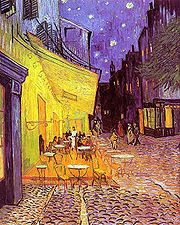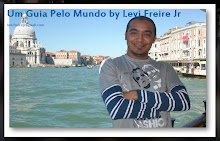 |
| Levi Freire Jr na Rue Lepic, 54 |
Localizada no Bairro de Montmartre é um dos locais que vale apena passar pela frente e tirar uma foto, pois, este grande artista do século XIX, Van Gogh, é considerado um dos pioneiros das tendências impressionistas. Naquela época, o impressionismo tomava conta das galerias de arte de Paris. É importante ressaltar que Vincent e Émile Bernard começaram o uso da técnica do pontilhismo, inspirados em Georges Seurat. Foi durante sua morada em Paris que Van Gogh abandonou a temática sombria e obscura de camponeses e suas obras recebem tons mais claros. São desta época os quadros Mulher sentada no Café du Tambourin, A ponte Grande Jatte sobre o Sena, Quatro Girassóis, os Retratos de Père Tanguy.
Nascido na Holanda em 1853, na cidade de Zundert, próximo a Breda, filho de um pastor de uma igreja reformada, Vincent Van Gogh aos 16 anos foi orientado pelo seu tio a trabalhar para um comerciante de artes na cidade de Haia, na empresa Goupil & Cie. Quatro anos depois mudou-se para Londres e Paris.
Nascido na Holanda em 1853, na cidade de Zundert, próximo a Breda, filho de um pastor de uma igreja reformada, Vincent Van Gogh aos 16 anos foi orientado pelo seu tio a trabalhar para um comerciante de artes na cidade de Haia, na empresa Goupil & Cie. Quatro anos depois mudou-se para Londres e Paris.
A formação religiosa herdada do pai, era um assunto que interessava bastante Van Gogh e com isto acabou sendo demitido deixando a França e retornando para Inglaterra. Decidiu retornar para a Holanda onde trabalhou em uma livraria, a maior parte de seu tempo era dedicada à tradução da Bíblia. Morou em Amsterdam, na Bélgica atuou como missionário em uma comunidade de mineiros ficou impressionado com a vida e o oficio destes trabalhadores. Inspirado, fez vários desenhos a lápis. Dividiu seus bens entre os pobres e passou a ser sustentado pelo irmão.
Em março de 1886, Van Gogh foi para Paris, dividiu um apartamento em Montmartre com o Irmão Theo, os dois mudaram-se para um apartamento maior na Rue Lepic, 54.
 |
| No terceiro andar, morou Van Gogh e, de lá, pintou a vista que tinha de sua janela. |
Através de seu irmão Theo, conheceu Monet, Renoir, Sisley, Pissarro, Degas, Signac e Seurat e trabalhando no Estúdio Cormon conheceu John Peter Russell, Émile Bernard e Henri de Toulouse-Lautrec, entre outros. Henri apresenta a van Gogh o absinto, bebida popular da ocasião, que viria a ser muito consumida pelo pintor, que a retratou em Natureza Morta com Absinto. O absinto possuía como principal ingrediente uma planta alucinógena a graduação alcoólica era de 68%. O absinto, também foi conhecido como "fada verde" devido aos efeitos alucinógenos.
 |
| Natureza Morta com Absinto |
Em 1888, Van Gogh atacou Gauguin com uma navalha. Atormentado pelo fracasso do ataque, Van Gogh cortou o próprio lóbulo da orelha esquerda com a navalha do ataque. Embrulhou-o e entregou a uma prostituta.
Em 1889 o pintor apresentava sinais de disfunção mental. Foi internado em um asilo, pelo irmão. Mas não deixou de pintar, fazendo obras que eram reconhecidas, cada vez mais, pela classe artística.
Em 1890, foi morar em Auvers-sur-Oise onde começou a pintar freneticamente. Em julho deste ano, o estado mental foi agravado e em um passeio, Van Gogh atirou contra si mesmo, no tórax. Foi encontrado por amigos e foi levado para o hospital. Após três dias de internação, não resistiu e morreu. O pintor passou as últimas horas de sua vida conversando com o irmão.
A genialidade de Van Gogh foi reconhecida apenas depois de sua morte, a sua obra mais famosa, "O Retrato de Dr. Gachet", foi vendida por US$ 82,5 milhões.
 |
| “Encontrei em Gachet um verdadeiro amigo“, escreveu van Gogh numa carta à irmã, “quase como um irmão“. |
Walking In Paris - The House of Van Gogh
 |
| Self-Portrait with Felt Hat, 1887 |
 Through
his brother Theo, he met Monet, Renoir Sisley, Pissarro, Degas, Seurat
and Signac and working in Cormon studio met John Peter Russell, Emile
Bernard and Henri de Toulouse-Lautrec, among others. Henri
van Gogh presents the wormwood, popular drink of the occasion, that
would be too consumed by the painter, portrayed in the Still Life with
Absinthe. Absinthe had as a main ingredient in the hallucinogenic plant alcohol content was 68%. Absinthe, also was known as the "green fairy" due to the hallucinogenic effects. In 1888, Van Gogh attacked Gauguin with a razor. Tormented by the failure of the attack, Van Gogh cut his own left ear lobe . He wrapped it and gave it to a prostitute. In 1889 the painter showed signs of mental dysfunction. He was hospitalized in an asylum by her brother. But not stopped painting, making works that were recognized, increasingly, by the artistic community. In 1890, he moved to Auvers-sur-Oise where he began to paint frantically. In July this year, the state of mind was aggravated and a walk, Van Gogh shot himself in the chest. It was found by friends and was taken to the hospital. After three days of hospitalization, did not survive and died. The painter spent the last hours of his life talking to his brother.
Through
his brother Theo, he met Monet, Renoir Sisley, Pissarro, Degas, Seurat
and Signac and working in Cormon studio met John Peter Russell, Emile
Bernard and Henri de Toulouse-Lautrec, among others. Henri
van Gogh presents the wormwood, popular drink of the occasion, that
would be too consumed by the painter, portrayed in the Still Life with
Absinthe. Absinthe had as a main ingredient in the hallucinogenic plant alcohol content was 68%. Absinthe, also was known as the "green fairy" due to the hallucinogenic effects. In 1888, Van Gogh attacked Gauguin with a razor. Tormented by the failure of the attack, Van Gogh cut his own left ear lobe . He wrapped it and gave it to a prostitute. In 1889 the painter showed signs of mental dysfunction. He was hospitalized in an asylum by her brother. But not stopped painting, making works that were recognized, increasingly, by the artistic community. In 1890, he moved to Auvers-sur-Oise where he began to paint frantically. In July this year, the state of mind was aggravated and a walk, Van Gogh shot himself in the chest. It was found by friends and was taken to the hospital. After three days of hospitalization, did not survive and died. The painter spent the last hours of his life talking to his brother.Van Gogh's genius was recognized only after his death, his most famous work, "Portrait of Dr. Gachet" was sold for $ 82.5 million.
Marcher à Paris - la maison de Van Gogh
 |
| Les Mangeurs de pommes de terre - 1885 |
 |
| La Terrasse de café à Arles Nuit, 1888 |
En Mars 1886, Van Gogh se rend à Paris, a partagé un appartement à Montmartre avec le frère Théo, les deux déménagé à un appartement plus grand dans la rue Lepic, 54. Grâce à son frère Théo, il a rencontré Monet, Renoir, Sisley, Pissarro, Degas, Seurat et Signac et le travail en studio de Cormon rencontré John Peter Russell, Emile Bernard et Henri de Toulouse-Lautrec, entre autres. Henri van Gogh présente l'absinthe, boisson populaire de l'occasion, ce serait trop consommé par le peintre, dépeint dans la Nature morte avec l'absinthe. Absinthe avait comme ingrédient principal dans la teneur en alcool plante hallucinogène a été de 68%. L'absinthe était également connu comme "Green Fairy" à cause des effets hallucinogènes. En 1888, Van Gogh a attaqué Gauguin avec un rasoir. Tourmenté par l'échec de l'attaque, Van Gogh lui coupa l'oreille gauche du lobe propres avec une attaque au couteau. Il l'enveloppa et il a donné à une prostituée. En 1889, le peintre a montré des signes de dysfonctionnement mental. Il a été hospitalisé dans un asile par son frère. Mais pas cessé de peindre, faire des œuvres qui ont été reconnus, en plus, par la communauté artistique. En 1890, il s'installe à Auvers-sur-Oise où il a commencé à peindre frénétiquement. En Juillet de cette année, l'état d'esprit a été aggravée et d'une promenade, Van Gogh se tire une balle dans la poitrine. Il a été trouvé par des amis et a été transporté à l'hôpital. Après trois jours d'hospitalisation, n'a pas survécu et est décédé. Le peintre a passé les dernières heures de sa vie à parler à son frère. Génie de Van Gogh a été reconnu seulement après sa mort, son œuvre la plus célèbre, "Portrait du Dr Gachet" a été vendu pour 82,5 millions de dollars.

Paris é lindo em qualquer estação do ano. Adorei seus comentários.
ResponderExcluir